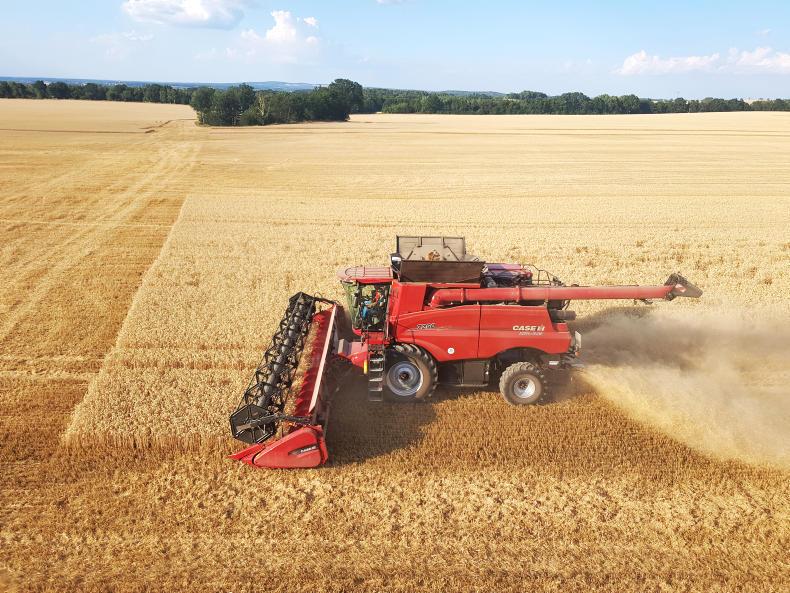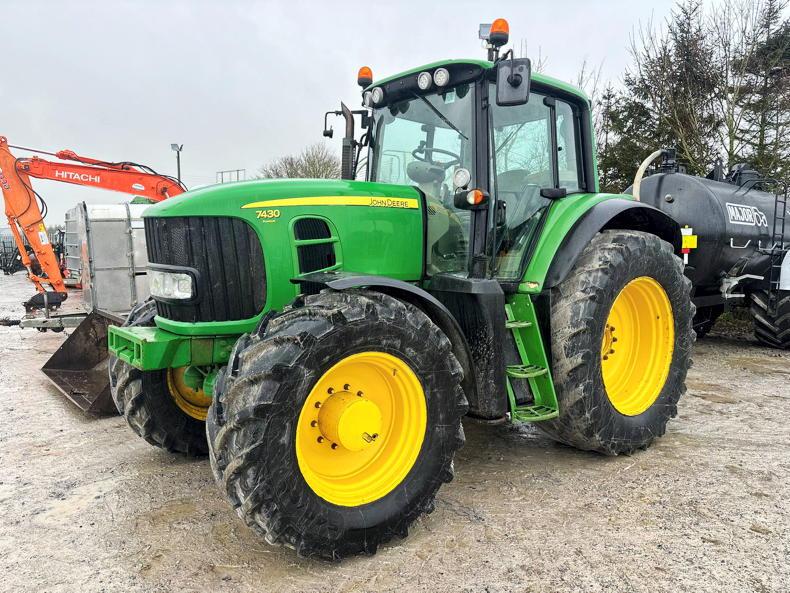According to the Case IH combine team, this is the largest update to the range since 2003. In a nutshell, the new range has become much more automated and intellectual while increasing throughput potential and capacity but retaining its focus on grain quality.
Feeder/intake upgrade
The feeder section of the combine has been built much heavier in the latest range to meet the demand of a growing header size. Strengthened feeder slats have been added using cast steel over what was originally pressed steel in order to further reinforce the feeder section.
The previous range was fitted with a standard 4.5t lift capacity. The newer range gives users the option of fitting one of three different feeders. The standard feeder is 4.5t, the middle range is 5.2t and the largest heavy-duty range is 6.1t. This is to meet the growing demand across Europe for combines to carry larger headers. These heavy-duty combines now have the capacity to carry headers of up to 13.5m (44ft). On average, the newest range has an 18% higher lifting capacity.
A new feature which will make life easier for the operator is the introduction of the hydraulic lateral tilt. It is now possible to hydraulically tilt the header forward and backwards from the cab, up to 12°, giving the combine a better chance to cut crops at different heights.
To accommodate the larger headers being fitted nowadays, a bigger gearbox has been added with the slip clutch set accordingly, to allow a greater load on the machine. The heavier headers have required a larger drive to be fitted. The drive-line to the header is now capable of delivering from 150hp to 170hp. In addition, new heavy-duty lift cylinders have been fitted. They are positioned at a lower level on the newer machines to allow the combine lift the feeder with higher force.
Automation
The addition of the AFS Harvest Command automation is the major update to the latest range from Case IH. This new technology works off the data of a total of 16 sensor units, which monitor the machine and its threshing progress. These sensors have the capability of adjusting seven different settings in an attempt to maintain maximum performance. This technology is managed through the in-cab display screen where the operator can see everything that is happening.
This AFS Harvest Command technology contains the automatic crop settings (ACS) system. This regulates items including fan speed and concave clearance depending on the crop type selected on the in-cab screen. Settings can be altered by the operator and saved for future use.
The new and updated combine range is fitted with the ‘‘Feedrate Control’’ option. This function finetunes ground speed depending on the crop load, while at the same time it monitors field losses, striving for maximum throughput. The operator can set the desired maximum engine load and ground speed, and the control function will work up to this limit.
The most advanced option available to an operator is full AFS Harvest Command automation, which automatically makes threshing and cleaning system adjustments based on the same anticipated results as Feedrate Control, with the addition of grain quality monitoring.
This system uses a specialised multi-spectrum camera to aid the machine in minimising impurities in the grain sample.
The camera uses infrared ultraviolet light to scan for impurities or cracked grains and will detect starch within those cracked grains.

The updated series includes a range of auger lengths to suit various controlled traffic farming (CTF) systems.
Transmission
The upgraded combine range has been fitted with a new hydrostatic transmission. The older models were fitted with a four-speed transmission, while the newer range has moved to a two-speed transmission, one for the field and one for the road.
Maximum respective speeds in each range are 18km/h and 40km/h, but these maximum speeds can be altered according to operator preference and field conditions. This new transmission allows for a hydraulic shift from field gear to the road gear from the armrest while on the move. On the previous range, the operator had to stop to shift from field to road gears.
This upgraded transmission is accompanied by an upgrade in size of hydrostatic pump and motor. The latest range has experienced a complete revamp in differential lock control application. The older range had a mechanical pedal, while the newer range has moved to a floor-mounted electrical button.
Braking has switched from an external disc on the older model to an internal oil-cooled brake on the recently updated range. According to Case officials, “this update reduces the required pedal pressure for the same braking effort and enhances the cooling required in situations where continuous braking is needed”.
Rotor cage and sieve
The new range of combines are fitted with adjustable rotor cage vanes, which can be activated from within the cab. These rotor cages can be manually adjusted or else they will adjust themselves if the automation feature is engaged.
The rear six vanes are linked. The update includes a superior range of adjustments, either from the cab or manually from ground level. By changing the angle of the vanes, it will either speed up or slow down the movement of the crop through the rotor cage. As a result, finetuning the threshing and separation process to the crop conditions.
The full AFS Harvest Command automation package also includes in-cab pre-sieve adjustment. This automation function automatically adjusts all sieve settings based on feedback from the loss sensors, grain camera and sieve pressure sensors. This option can also be operated manually from within the cab.
COMMENT
From glancing at Case IH’s most recent updated combine range from a distance, there is nothing new except the numbering of the models. No external changes as such have been made to the machine.
As you get closer, you can see that the feeder section is physically built heavier, which is to deal with increasing header sizes and to increase throughput levels.
Having spent a brief period harvesting a dry crop of wheat with the new machine, the added automation features makes the machine very intelligent and are designed to keep productivity levels at a high.
Case IH has removed the niggly bits where stress may occur by the operator while setting up the combine for maximum throughput while prioritising grain quality.
The addition of a range of auger lengths to suit various controlled traffic farming (CTF) systems is a welcome move for the industry, especially as there will be more and more of a focus on CTF in the coming years.
According to the Case IH combine team, this is the largest update to the range since 2003. In a nutshell, the new range has become much more automated and intellectual while increasing throughput potential and capacity but retaining its focus on grain quality.
Feeder/intake upgrade
The feeder section of the combine has been built much heavier in the latest range to meet the demand of a growing header size. Strengthened feeder slats have been added using cast steel over what was originally pressed steel in order to further reinforce the feeder section.
The previous range was fitted with a standard 4.5t lift capacity. The newer range gives users the option of fitting one of three different feeders. The standard feeder is 4.5t, the middle range is 5.2t and the largest heavy-duty range is 6.1t. This is to meet the growing demand across Europe for combines to carry larger headers. These heavy-duty combines now have the capacity to carry headers of up to 13.5m (44ft). On average, the newest range has an 18% higher lifting capacity.
A new feature which will make life easier for the operator is the introduction of the hydraulic lateral tilt. It is now possible to hydraulically tilt the header forward and backwards from the cab, up to 12°, giving the combine a better chance to cut crops at different heights.
To accommodate the larger headers being fitted nowadays, a bigger gearbox has been added with the slip clutch set accordingly, to allow a greater load on the machine. The heavier headers have required a larger drive to be fitted. The drive-line to the header is now capable of delivering from 150hp to 170hp. In addition, new heavy-duty lift cylinders have been fitted. They are positioned at a lower level on the newer machines to allow the combine lift the feeder with higher force.
Automation
The addition of the AFS Harvest Command automation is the major update to the latest range from Case IH. This new technology works off the data of a total of 16 sensor units, which monitor the machine and its threshing progress. These sensors have the capability of adjusting seven different settings in an attempt to maintain maximum performance. This technology is managed through the in-cab display screen where the operator can see everything that is happening.
This AFS Harvest Command technology contains the automatic crop settings (ACS) system. This regulates items including fan speed and concave clearance depending on the crop type selected on the in-cab screen. Settings can be altered by the operator and saved for future use.
The new and updated combine range is fitted with the ‘‘Feedrate Control’’ option. This function finetunes ground speed depending on the crop load, while at the same time it monitors field losses, striving for maximum throughput. The operator can set the desired maximum engine load and ground speed, and the control function will work up to this limit.
The most advanced option available to an operator is full AFS Harvest Command automation, which automatically makes threshing and cleaning system adjustments based on the same anticipated results as Feedrate Control, with the addition of grain quality monitoring.
This system uses a specialised multi-spectrum camera to aid the machine in minimising impurities in the grain sample.
The camera uses infrared ultraviolet light to scan for impurities or cracked grains and will detect starch within those cracked grains.

The updated series includes a range of auger lengths to suit various controlled traffic farming (CTF) systems.
Transmission
The upgraded combine range has been fitted with a new hydrostatic transmission. The older models were fitted with a four-speed transmission, while the newer range has moved to a two-speed transmission, one for the field and one for the road.
Maximum respective speeds in each range are 18km/h and 40km/h, but these maximum speeds can be altered according to operator preference and field conditions. This new transmission allows for a hydraulic shift from field gear to the road gear from the armrest while on the move. On the previous range, the operator had to stop to shift from field to road gears.
This upgraded transmission is accompanied by an upgrade in size of hydrostatic pump and motor. The latest range has experienced a complete revamp in differential lock control application. The older range had a mechanical pedal, while the newer range has moved to a floor-mounted electrical button.
Braking has switched from an external disc on the older model to an internal oil-cooled brake on the recently updated range. According to Case officials, “this update reduces the required pedal pressure for the same braking effort and enhances the cooling required in situations where continuous braking is needed”.
Rotor cage and sieve
The new range of combines are fitted with adjustable rotor cage vanes, which can be activated from within the cab. These rotor cages can be manually adjusted or else they will adjust themselves if the automation feature is engaged.
The rear six vanes are linked. The update includes a superior range of adjustments, either from the cab or manually from ground level. By changing the angle of the vanes, it will either speed up or slow down the movement of the crop through the rotor cage. As a result, finetuning the threshing and separation process to the crop conditions.
The full AFS Harvest Command automation package also includes in-cab pre-sieve adjustment. This automation function automatically adjusts all sieve settings based on feedback from the loss sensors, grain camera and sieve pressure sensors. This option can also be operated manually from within the cab.
COMMENT
From glancing at Case IH’s most recent updated combine range from a distance, there is nothing new except the numbering of the models. No external changes as such have been made to the machine.
As you get closer, you can see that the feeder section is physically built heavier, which is to deal with increasing header sizes and to increase throughput levels.
Having spent a brief period harvesting a dry crop of wheat with the new machine, the added automation features makes the machine very intelligent and are designed to keep productivity levels at a high.
Case IH has removed the niggly bits where stress may occur by the operator while setting up the combine for maximum throughput while prioritising grain quality.
The addition of a range of auger lengths to suit various controlled traffic farming (CTF) systems is a welcome move for the industry, especially as there will be more and more of a focus on CTF in the coming years.












SHARING OPTIONS